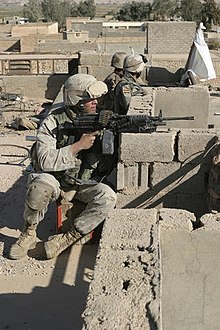Operation_Steel_Curtain
Operation Steel Curtain (Arabic: الحجاب الفولاذي Al Hejab Elfulathi) was a military operation executed by coalition forces in early November 2005 to reduce the flow of foreign insurgents crossing the border and joining the Iraqi insurgency. The operation was important in that it was the first large scale deployment of the New Iraqi Army. This offensive was part of the larger Operation Sayeed (Hunter), designed to prevent al Qaeda in Iraq from operating in the Euphrates River Valley and throughout Al Anbar and to establish a permanent Iraqi Army presence in the Al Qa’im region.
